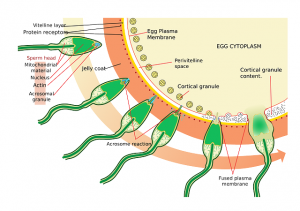
Adequate intakes of selenium for the synthesis of the selenoproteins are necessary to produce mature and viable sperm. The selenoprotein GPX4 seems to be indispensable:
- to the development and maturation of the sperm cells
- to the antioxidant protection of the sperm cells
- to the structural cohesiveness of the sperm cells
- to the motility and viability of the sperm cells [Foresta]
Selenium and semen quality
What are we talking about here? Let’s define some terms that are relevant to male fertility.
Our bodies produce semen by combining sperm cells from the testicles with various fluids from the seminal vesicles, the prostate, and the two small glands called Cowper’s glands. The semen needs to contain high counts of sperm cells – perhaps 200 million plus – and needs to contain sperm cells capable of good motility if one of the sperm cells is to succeed in reaching and fertilizing the mature female egg.
Motility is the biologists’ term for the ability of cells and organisms to use energy to move spontaneously and actively.
Selenium supplementation and semen quality
What do studies of selenium supplementation show? Is there an effect of selenium supplementation on the quality of the semen?
Dr. Safarinejad has tested the effectiveness of selenium supplementation in improving semen parameters in infertile men. His study enrolled 116 infertile men who received 200 micrograms of selenium daily and 118 infertile men who received a matching placebo for 26 weeks.
The men ranged in age from 25 to 48 years with a mean age of 31 years. The volume of the men’s testicles did not differ significantly from one group to the other.
At the start of the study, the researchers measured mean total sperm count, sperm concentration, semen volume, sperm motility, and sperm morphology as well as plasma selenium concentration and semen selenium concentration. They did not find any significant differences between the two groups [Safarinejad].
Increases in plasma selenium concentrations
Already after one month of supplementation with selenium, the men’s plasma selenium concentrations increased significantly. The plasma selenium levels then remained constant for the remainder of the treatment period.
Increases in semen selenium concentrations
Semen selenium levels responded to the selenium supplementation somewhat more slowly, plateauing only after 12 weeks of supplementation.
Increases in sperm count and sperm motility
At the end of the 26-week study, the researchers found that the supplementation with selenium had significantly increased the mean total sperm count compared with placebo. Similarly, after 26 weeks, the selenium supplementation was associated with a significant increase in mean sperm motility compared with placebo. This was good news.
In sum, daily supplementation with 200 micrograms of selenium significantly improved the semen parameters of infertile men. In the aggregate, the improvements amounted to a 30% increase in sperm count, a 19% increase in sperm motility and a 26% improvement in sperm morphology. Moreover, the researchers noted no adverse effects of the selenium supplementation.
The researchers continued to follow the study participants after the end of the 26-week period of supplementation. By week 56, with no more supplementation, the plasma selenium and semen selenium levels had reverted to baseline levels. The semen parameters also gradually reverted to baseline levels because the selenium supplementation had ceased.
A second study of selenium supplementation and semen motility
Dr. Scott, Dr. MacPherson, and their research colleagues conducted a randomized controlled study in which they assigned 69 men with low selenium status and low sperm motility to one of three study groups:
- a selenium alone group
- a group receiving selenium plus vitamins A, C, and E
- a placebo group
The study participants took the supplements or placebo daily for 3 months. At the end of the study, the researchers tested the study participants’ plasma selenium status and semen quality once again.
Increases in plasma selenium levels
The supplementation with selenium increased plasma selenium concentrations significantly in both selenium-treated groups. Plasma selenium levels did not rise appreciably in control participants.
Increases in sperm motility
By the end of the study, the sperm motility of the participants in both selenium supplemented groups had increased whereas the sperm motility in the placebo group participants had declined slightly. However, the increases in sperm motility in the treated groups were not sufficiently high to be statistically significant.
When, however, the researchers combined the results from the two selenium-supplemented groups and compared the combined results with the results from the placebo group, then the selenium treatment was significantly associated with increased sperm motility.
Dr. Scott et al concluded that selenium supplementation can improve sperm motility in sub-fertile men who have low selenium status. In that way, selenium supplementation can improve the chance of successful conception.
Selenium supplementation is a simple and inexpensive remedy to male infertility
The Safarinejad study and the Scott study show that selenium supplementation is a simple, safe, and relatively inexpensive method of improving the semen parameters of infertile men.
Sources
Foresta, C., Flohé, L., Garolla, A., Roveri, A., Ursini, F., & Maiorino, M. (2002). Male fertility is linked to the selenoprotein phospholipid hydroperoxide glutathione peroxidase. Biology Of Reproduction, 67(3), 967-971.
Rayman, M. P. (2012). Selenium and human health. Lancet (London, England), 379(9822), 1256-1268.
Safarinejad, M. R., & Safarinejad, S. (2009). Efficacy of selenium and/or N-acetyl-cysteine for improving semen parameters in infertile men: a double-blind, placebo controlled, randomized study. The Journal of Urology, 181(2), 741-751.
Scott, R., MacPherson, A., Yates, R. W., Hussain, B., & Dixon, J. (1998). The effect of oral selenium supplementation on human sperm motility. British Journal of Urology, 82(1), 76-80.
Strauss, E. (1999). Selenium’s role in infertility explained. Science, 285, 1339.
Disclaimer: The information presented in this article is not intended as medical advice and should be considered as such.
